Abstract
The induction of human influenza virus-specific memory cytotoxic T lymphocytes (CTL) from CTL precursors (CTLp) was investigated using limiting-dilution cultures and cell lines. Differentiation of maximal numbers of CTLp in limiting-dilution cultures required at least three signals: antigen stimulation, interleukin-2 (IL-2), and a differentiation factor distinct from IL-2. Antigen-specific CTLp proliferated in response to antigen stimulation and recombinant DNA-derived IL-2, but often failed to acquire cytolytic activity unless conditioned medium (CM) from mitogen-stimulated peripheral blood mononuclear cell (PBMC) cultures was added to the cultures. Temporal analysis of the requirement for CM indicated that it was providing a late signal for CTLp differentiation. This analysis was confirmed by developing CTLp cell lines, which were found to proliferate in response to IL-2 and antigen but not to exhibit influenza virus-specific cytotoxicity until CM was added.
Full text
PDF
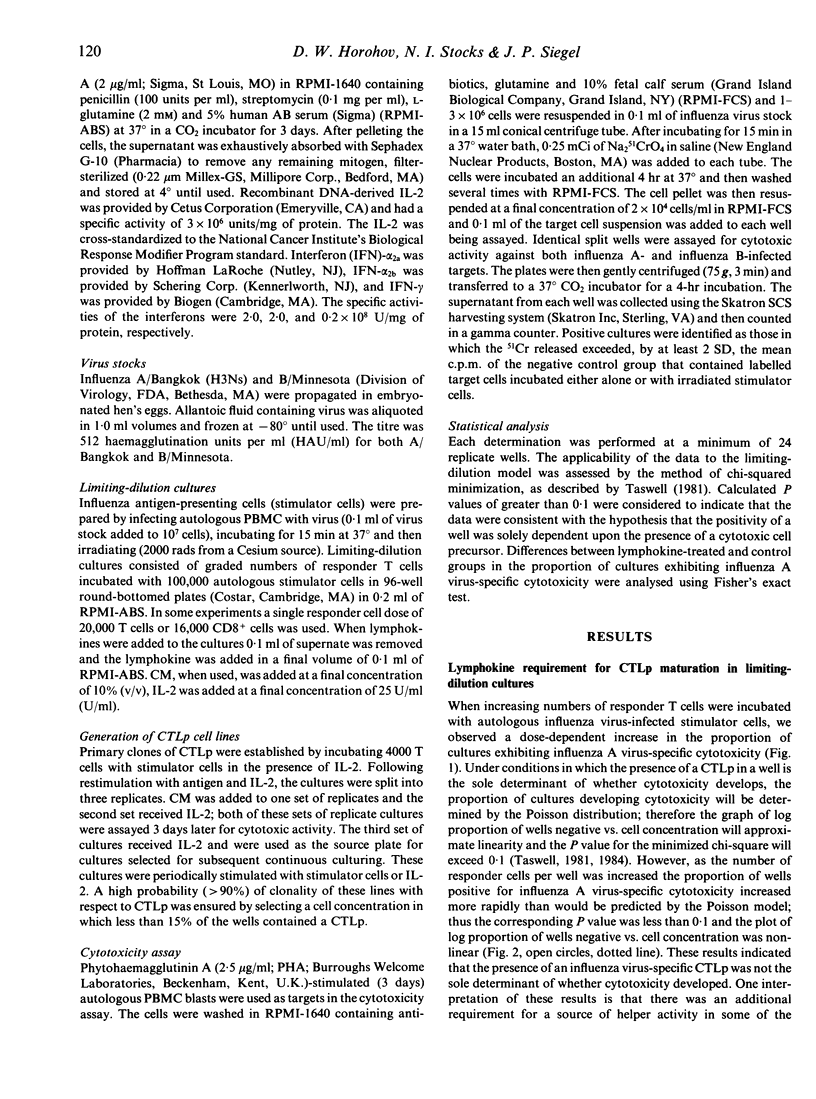
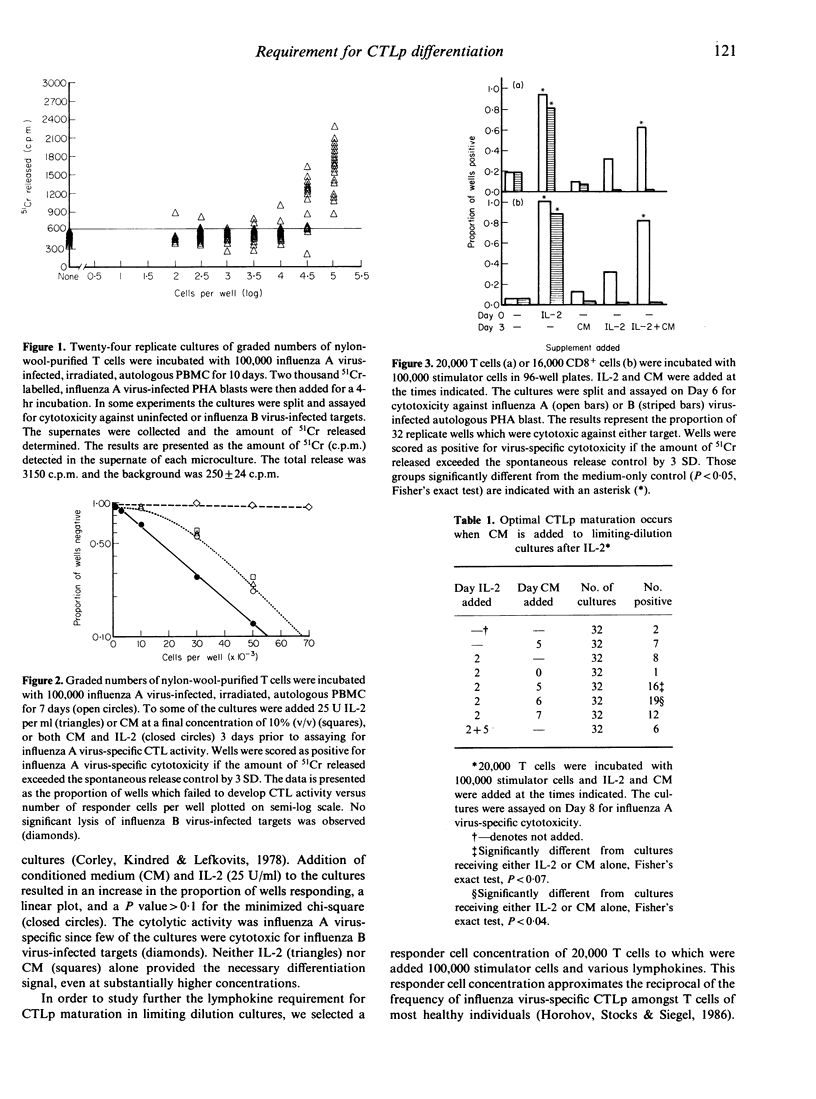
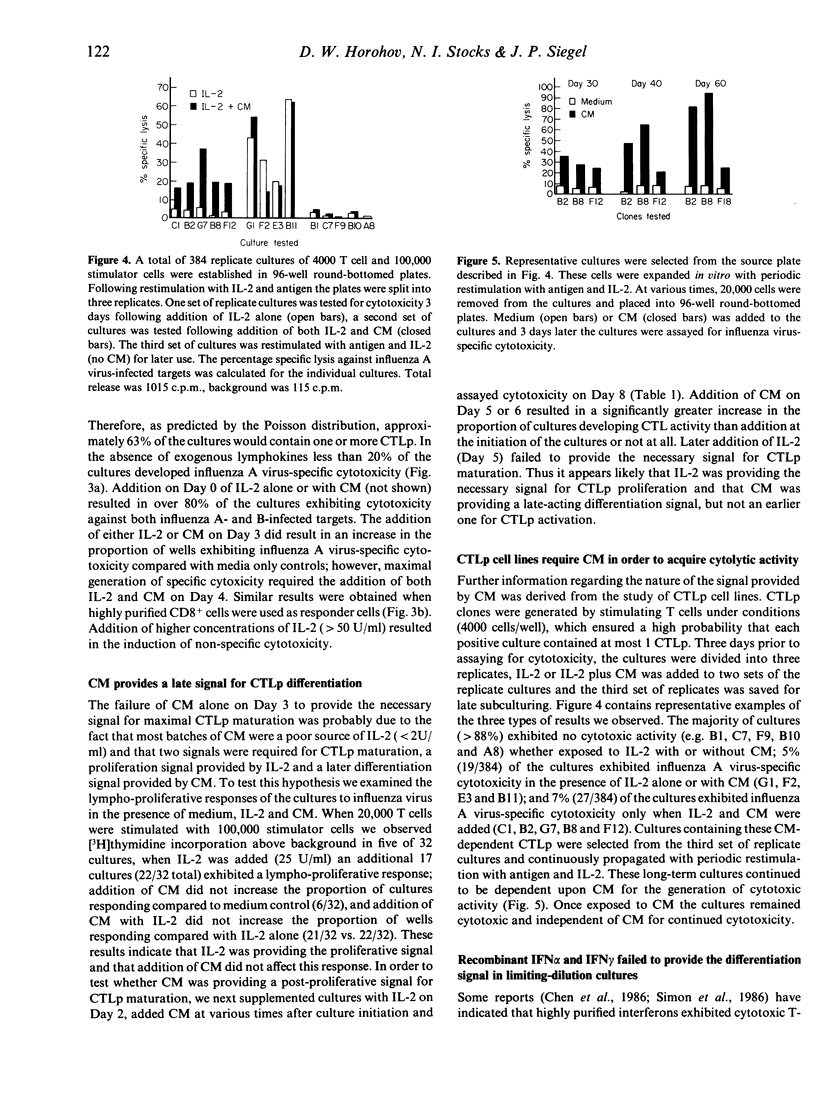
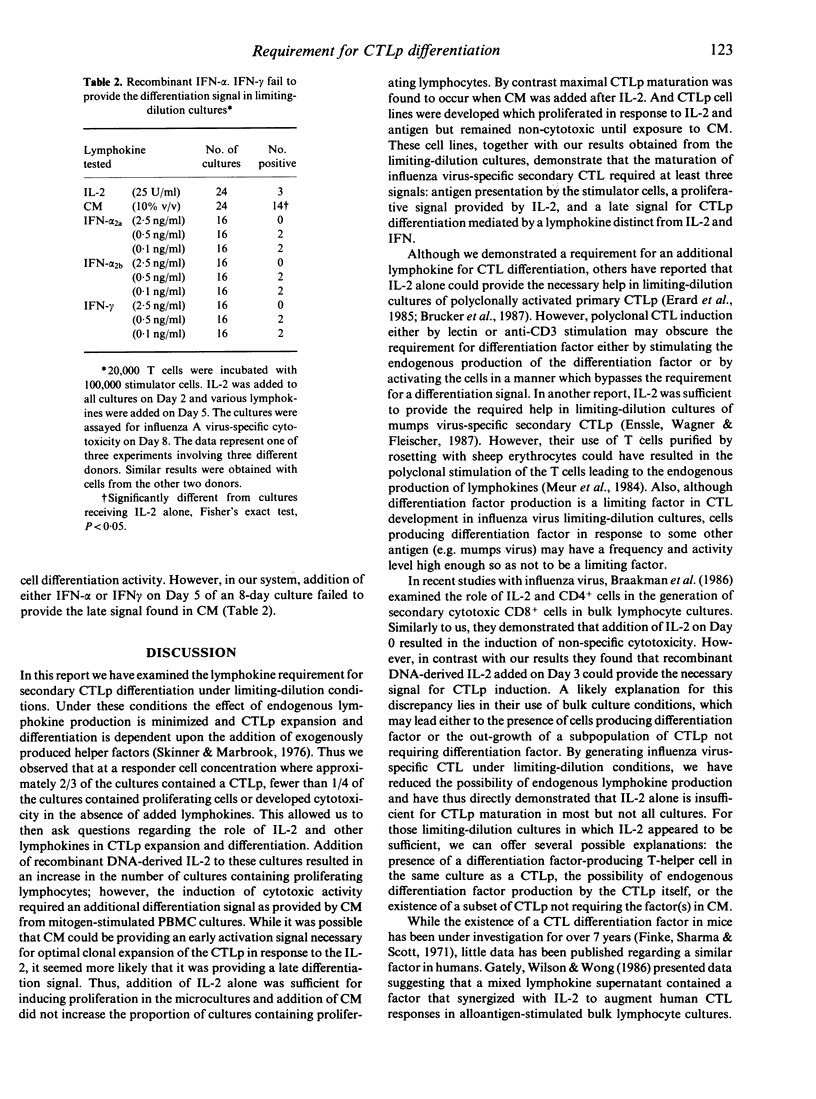
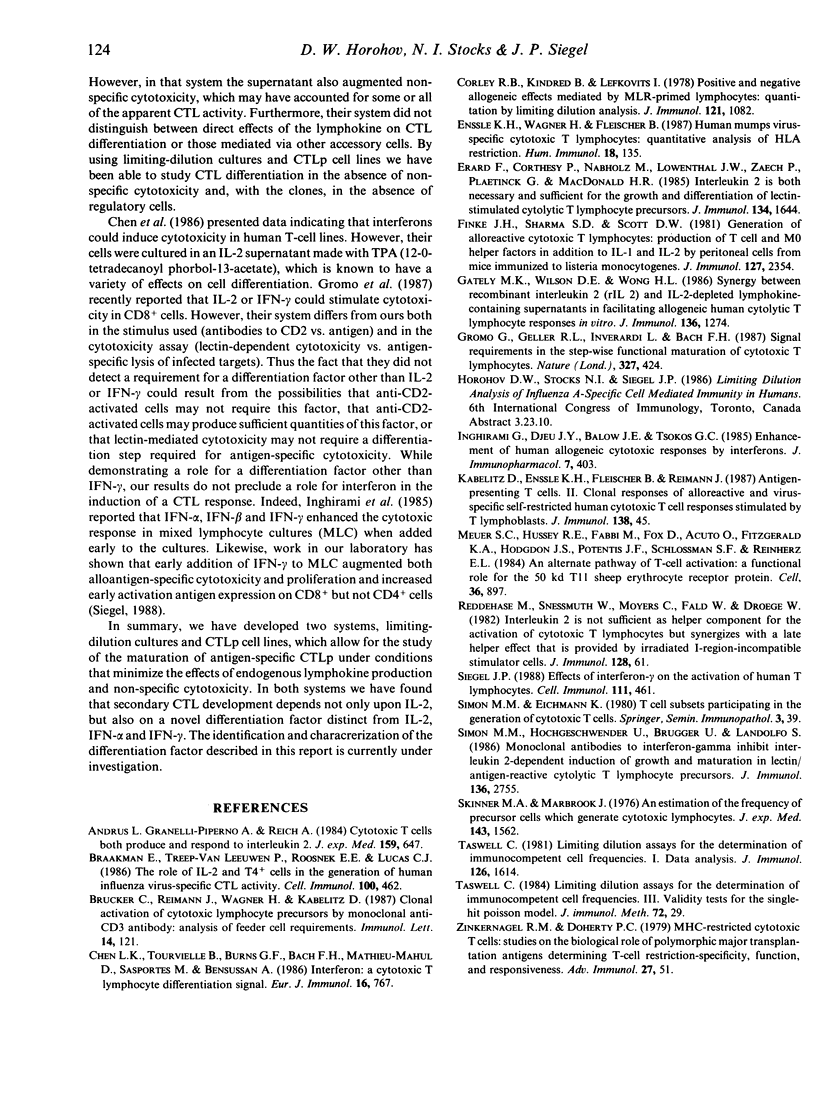
Selected References
These references are in PubMed. This may not be the complete list of references from this article.
- Andrus L., Granelli-Piperno A., Reich E. Cytotoxic T cells both produce and respond to interleukin 2. J Exp Med. 1984 Feb 1;159(2):647–652. doi: 10.1084/jem.159.2.647. [DOI] [PMC free article] [PubMed] [Google Scholar]
- Braakman E., Treep-Van Leeuwen P., Roosnek E. E., Lucas C. J. The role of IL-2 and T4+ cells in the generation of human influenza virus-specific CTL activity. Cell Immunol. 1986 Jul;100(2):462–473. doi: 10.1016/0008-8749(86)90045-6. [DOI] [PubMed] [Google Scholar]
- Brucker C., Reimann J., Wagner H., Kabelitz D. Clonal activation of cytotoxic lymphocyte precursors by monoclonal anti-CD3 antibody: analysis of feeder cell requirements. Immunol Lett. 1987 Jan;14(2):121–125. doi: 10.1016/0165-2478(87)90090-3. [DOI] [PubMed] [Google Scholar]
- Chen L. K., Tourvieille B., Burns G. F., Bach F. H., Mathieu-Mahul D., Sasportes M., Bensussan A. Interferon: a cytotoxic T lymphocyte differentiation signal. Eur J Immunol. 1986 Jul;16(7):767–770. doi: 10.1002/eji.1830160709. [DOI] [PubMed] [Google Scholar]
- Corley R. B., Kindred B., Lefkovits I. Positive and negative allogeneic effects mediated by MLR-primed lymphocytes: quantitation by limiting dilution analysis. J Immunol. 1978 Sep;121(3):1082–1089. [PubMed] [Google Scholar]
- Enssle K. H., Wagner H., Fleischer B. Human mumps virus-specific cytotoxic T lymphocytes: quantitative analysis of HLA restriction. Hum Immunol. 1987 Feb;18(2):135–149. doi: 10.1016/0198-8859(87)90011-5. [DOI] [PubMed] [Google Scholar]
- Erard F., Corthesy P., Nabholz M., Lowenthal J. W., Zaech P., Plaetinck G., MacDonald H. R. Interleukin 2 is both necessary and sufficient for the growth and differentiation of lectin-stimulated cytolytic T lymphocyte precursors. J Immunol. 1985 Mar;134(3):1644–1652. [PubMed] [Google Scholar]
- Finke J. H., Sharma S. D., Scott J. W. Generation of alloreactive cytotoxic T lymphocytes: production of T cell and macrophage helper factors in addition to IL 1 and IL 2 by peritoneal cells from mice immunized to Listeria monocytogenes. J Immunol. 1981 Dec;127(6):2354–2361. [PubMed] [Google Scholar]
- Gately M. K., Wilson D. E., Wong H. L. Synergy between recombinant interleukin 2 (rIL 2) and IL 2-depleted lymphokine-containing supernatants in facilitating allogeneic human cytolytic T lymphocyte responses in vitro. J Immunol. 1986 Feb 15;136(4):1274–1282. [PubMed] [Google Scholar]
- Gromo G., Geller R. L., Inverardi L., Bach F. H. Signal requirements in the step-wise functional maturation of cytotoxic T lymphocytes. Nature. 1987 Jun 4;327(6121):424–426. doi: 10.1038/327424a0. [DOI] [PubMed] [Google Scholar]
- Inghirami G., Djeu J. Y., Balow J. E., Tsokos G. C. Enhancement of human allogeneic cytotoxic responses by interferons. J Immunopharmacol. 1985;7(4):403–415. doi: 10.3109/08923978509026484. [DOI] [PubMed] [Google Scholar]
- Kabelitz D., Enssle K. H., Fleischer B., Reimann J. Antigen-presenting T cells. II. Clonal responses of alloreactive and virus-specific self-restricted human cytotoxic T cell responses stimulated by T lymphoblasts. J Immunol. 1987 Jan 1;138(1):45–50. [PubMed] [Google Scholar]
- Meuer S. C., Hussey R. E., Fabbi M., Fox D., Acuto O., Fitzgerald K. A., Hodgdon J. C., Protentis J. P., Schlossman S. F., Reinherz E. L. An alternative pathway of T-cell activation: a functional role for the 50 kd T11 sheep erythrocyte receptor protein. Cell. 1984 Apr;36(4):897–906. doi: 10.1016/0092-8674(84)90039-4. [DOI] [PubMed] [Google Scholar]
- Reddehase M., Suessmuth W., Moyers C., Falk W., Droege W. Interleukin 2 is not sufficient as helper component for the activation of cytotoxic T lymphocytes but synergizes with a late helper effect that is provided by irradiated I-region-incompatible stimulator cells. J Immunol. 1982 Jan;128(1):61–68. [PubMed] [Google Scholar]
- Siegel J. P. Effects of interferon-gamma on the activation of human T lymphocytes. Cell Immunol. 1988 Feb;111(2):461–472. doi: 10.1016/0008-8749(88)90109-8. [DOI] [PubMed] [Google Scholar]
- Simon M. M., Eichmann K. T cell subsets participating in the generation of cytotoxic T cells. Springer Semin Immunopathol. 1980 May;3(1):39–62. doi: 10.1007/BF00199925. [DOI] [PubMed] [Google Scholar]
- Simon M. M., Hochgeschwender U., Brugger U., Landolfo S. Monoclonal antibodies to interferon-gamma inhibit interleukin 2-dependent induction of growth and maturation in lectin/antigen-reactive cytolytic T lymphocyte precursors. J Immunol. 1986 Apr 15;136(8):2755–2762. [PubMed] [Google Scholar]
- Skinner M. A., Marbrook J. An estimation of the frequency of precursor cells which generate cytotoxic lymphocytes. J Exp Med. 1976 Jun 1;143(6):1562–1567. doi: 10.1084/jem.143.6.1562. [DOI] [PMC free article] [PubMed] [Google Scholar]
- Taswell C. Limiting dilution assays for the determination of immunocompetent cell frequencies. I. Data analysis. J Immunol. 1981 Apr;126(4):1614–1619. [PubMed] [Google Scholar]
- Taswell C. Limiting dilution assays for the determination of immunocompetent cell frequencies. III. Validity tests for the single-hit Poisson model. J Immunol Methods. 1984 Aug 3;72(1):29–40. doi: 10.1016/0022-1759(84)90430-7. [DOI] [PubMed] [Google Scholar]
- Zinkernagel R. M., Doherty P. C. MHC-restricted cytotoxic T cells: studies on the biological role of polymorphic major transplantation antigens determining T-cell restriction-specificity, function, and responsiveness. Adv Immunol. 1979;27:51–177. doi: 10.1016/s0065-2776(08)60262-x. [DOI] [PubMed] [Google Scholar]


